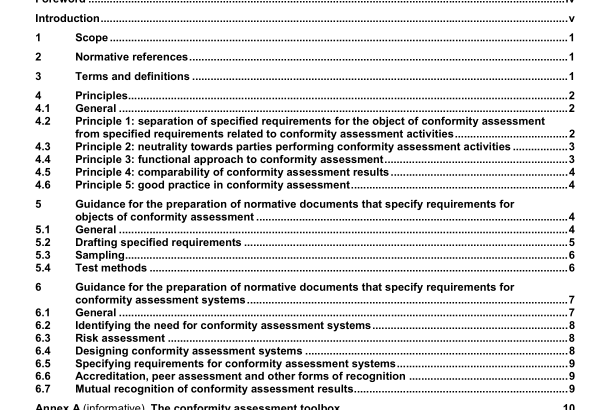ISO IEC 17007:2009 pdf download – Conformity assessment — Guidance for drafting normative documents suitable for use for conformity assessment
These conformity assessment functions are described more fully in 6.4, as well as in ISO/IEC 17000:2004, Annex A. Each of the various kinds of users of conformity assessment has specific needs. As a result, there is much variety in the way conformity assessment is performed. However, all types of conformity assessment follow the same general approach, characterized by the functions listed above. The benefits of the functional approach include the following:
a) thorough consideration of all functions of conformity assessment, including clear interfaces between conformity assessment functions;
b) greater substance and credibility that aims of conformity assessment functions are fulfilled;
c) greater consistency and possibility of harmonization among national, regional and international conformity assessment activities, thus facilitating mutual recognition and trade.
4.5 Principle 4: comparability of conformity assessment results The requirements for the objects of conformity assessment (Clause 5) and the requirements for the conformity assessment activities (Clause 6) should be specified in a clear and unambiguous manner, with sufficient detail to ensure that conformity assessment results will be comparable and reproducible. An important outcome of standardization and of conformity assessment activities is confidence in the objects’ fulfilment of specified requirements and the realization of the intended benefits (e.g. interoperability with other products or reduction of safety risks). If different parties (i.e. people, bodies and/or organizations) are applying the specified requirements to produce the object of conformity assessment, the resultant objects should all be comparable with respect to fulfilment of the requirements specified. If conformity with the specified requirements is assessed by different parties, the results of the conformity assessment should be comparable.
4.6 Principle 5: good practice in conformity assessment Developers of normative documents for conformity assessment activities should consider International Standards and Guides as a source of good practice in conformity assessment. ISO and IEC have developed a series of International Standards and Guides to promote the international comparability and credibility of conformity assessment activities, known as the conformity assessment toolbox. The criteria contained in these documents represent an international consensus on what constitutes good practice in conformity assessment. Using these documents fosters international compatibility and may avoid technical barriers to trade. Annex A lists all the documents that constitute the conformity assessment toolbox.
5 Guidance for the preparation of normative documents that specify requirements for objects of conformity assessment
5.1 General
5.1.1 Objects of conformity assessment may be products (including services), materials, installations, processes, systems, persons or bodies. Although the guidance in this clause may appear to be biased towards tangible products, developers of normative documents should interpret this guidance to apply to other objects of conformity assessment. Some examples are provided in 5.2.5.
5.1.2 This clause does not apply to conformity assessment systems and bodies as objects of conformity assessment.
5.2 Drafting specified requirements
5.2.1 Specified requirements relating to the characteristics of the object of conformity assessment should be stated in the clauses that form the normative parts of the document.
5.2.2 Specified requirements should be written in such a way that they are clear, direct and precise and will result in accurate and uniform interpretation, so that parties making use of the normative document are able to derive from the contents of the normative document a common understanding of its meaning and intent.
5.2.3 Normative documents for objects of conformity assessment should focus only on the criteria or performance characteristics of the object.
5.2.4 Normative documents may specify test methods for determining that the criteria or characteristics have been met. They should be expressed in such a way that any interested party may carry out the testing. It should be left to the users of the normative document to decide what conformity assessment activity (if any) will be utilized, who will carry out the conformity assessment and under what conditions.
5.2.5 Specified requirements should be written in terms of results or outcomes, together with limiting values and tolerances, where pertinent, and the methods of determination, such as test methods or inspection, in order to verify the specified characteristics. Examples of results or outcomes for a variety of objects of conformity assessment include:
⎯ a manufactured component specified in terms of durability and interoperability within an assembly;ISO IEC 17007 pdf download.
